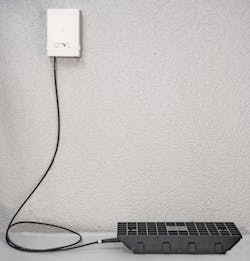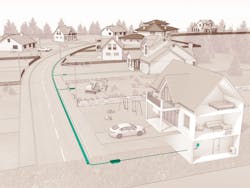Huber+Suhner intros FTTH modular connectivity geared for self-installation
A new fiber-to-the-home (FTTH) modular connectivity platform from Huber+Suhner enables subscribers to partially install their own fiber. Dubbed RESA, the platform is designed for deployment rural/ suburban residential and commercial areas.
The modular connectivity solution includes the buried RESA Splice Closure (RESA SC), the pre-connectorized Building Entry Point (RESA BEP) module and the pre-terminated Q-ODC-2 mini cable. The platform can endure harsh outdoor conditions per the IP68 rating in a multitude of climates, and will provide long-term FTTH network connectivity to customers.
According to the company, the RESA modular connectivity line's deployment is split into two different phases: homes passed and homes connected. In the first stage, the carriers pre-install the RESA splice closure box underground in the street. For the second phase, subscribers, without needing any fiber-optic knowledge, are given simple instructions on how to install the last few meters of the FTTH connection within the boundaries of their own property.
The RESA line is billed as an easy installation alternative for both carriers and end users. The manufacturer says the platform is designed to reduce the costs, time and resources required for rolling out FTTH networks, while giving subscribers more convenience and choice.
“We are excited to see RESA accelerate FTTH deployments to support a key goal for the industry,” commented Daniel Berz, market manager for fixed access networks at Huber+Suhner. “The convenience and flexibility to subscribers will also greatly contribute to carriers’ network rollout business as they can deliver more FTTH deployments in less time and at a lower cost.”
A company statement contends that the "first part of RESA system can be laid by the carrier in one go, reducing a historically timely and costly process. This improves the subscriber experience by greatly reducing the time they spend on the FTTH rollout waiting list, and eliminating the need to allocate time for FTTH installers to work at their private property."
Huber+Suhner's Berz concluded: “The RESA design greatly reduces carriers’ time and resources involved in coordinating FTTH installations at multiple properties. Its plug and play functionality makes for easy installation, which streamlines the process and allows for individual adaptions based on connectivity demands. It is really ideal for FTTH rollouts in rural or suburban residential areas, where there are plenty of single or dual family houses."
For more news, projects, and profiles in the ICT cabling and connectivity industry, subscribe to CI&M’s newsletter and follow us on LinkedIn, Twitter, and Facebook.
About the Author
Matt Vincent
Senior Editor
Matt Vincent is a B2B technology journalist, editor and content producer with over 15 years of experience, specializing in the full range of media content production and management, as well as SEO and social media engagement best practices, for both Cabling Installation & Maintenance magazine and its website CablingInstall.com. He currently provides trade show, company, executive and field technology trend coverage for the ICT structured cabling, telecommunications networking, data center, IP physical security, and professional AV vertical market segments. Email: [email protected]


